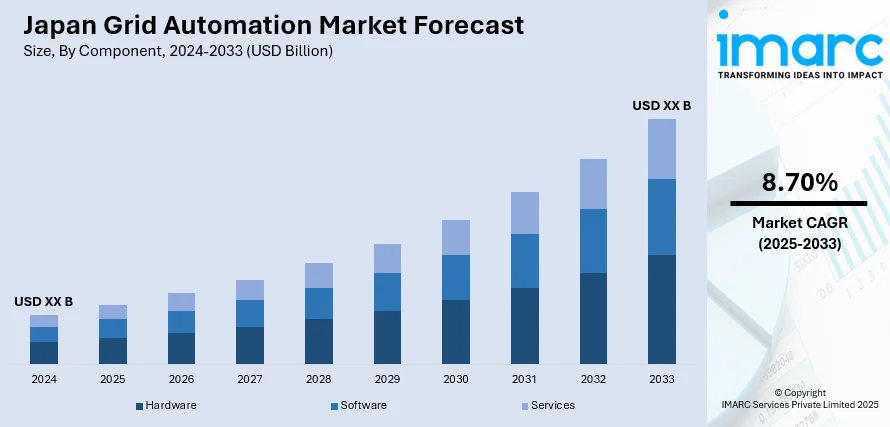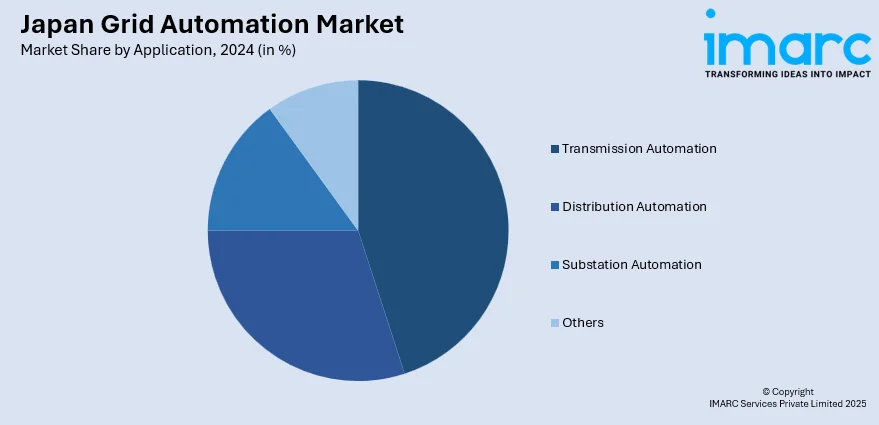
Japan Grid Automation Market Size, Share, Trends and Forecast by Component, Application, End-User, and Region, 2025-2033
Japan Grid Automation Market Overview:
The Japan grid automation market size is anticipated to exhibit a growth rate (CAGR) of 8.70% during 2025-2033. The market is fueled by the growing need for stable power, renewable energy integration, government policy, and smart grid system technology improvements. These drivers are boosting the Japan grid automation market share in the energy sector.
|
Report Attribute
|
Key Statistics
|
|---|---|
|
Base Year
|
2024
|
|
Forecast Years
|
2025-2033
|
|
Historical Years
|
2019-2024
|
| Market Growth Rate 2025-2033 | 8.70% |
Japan Grid Automation Market Trends:
Smart Grid Integration
Inclusion of smart grids in Japan's energy infrastructure is one of the most prominent drivers in the growth of Japan grid automation market. Real-time monitoring, improved grid stability, and increased energy efficiency are all provided by smart grid technology, which makes it convenient for Japan to manage its complex energy demand. Smart grids ensure an effective way of balancing demand and supply with growing renewable energy sources in Japan. The market is also gaining due to government initiatives for the adoption of such sophisticated systems, further boosting the market. Moreover, smart sensors and meters provide vital data to grid managers, which facilitates the location of faults and improvement in response times and contributes to long-term sustainability. For instance, in February 2024, at DISTRIBUTECH 2024, Schneider Electric showcased advanced AI-powered solutions and its Grid DERMS platform to accelerate grid modernization. Recognized by Guidehouse Insights as a leader in DERMS, Schneider unveiled innovations like EcoStruxure ADMS, ArcFM XI GIS, and Power Automation Systems. These tools enhance distributed energy management, optimize grid reliability, and support decarbonization.

Renewable Energy Integration
The shift toward renewable energy sources is another key trend driving the Japan grid automation market growth. As Japan increases its use of solar, wind, and other renewable energy, it faces challenges in managing intermittent power generation. Grid automation helps address these challenges by enabling efficient energy management and integration. Advanced automation systems allow for seamless coordination between renewable energy generation and traditional power plants, ensuring grid stability even when renewable generation fluctuates. This integration is crucial for Japan to meet its energy security goals while adhering to carbon reduction targets, which, in turn, supports the growing demand for grid automation technologies in the country. For instance, in June 2024, Hitachi Energy announced plans to invest an additional USD 4.5 Billion by 2027 to accelerate the clean energy transition. The investment will focus on enhancing manufacturing, R&D, digital solutions, and partnerships. Key projects include expanding HVDC and high-voltage products, supporting global renewable energy goals.
Japan Grid Automation Market Segmentation:
IMARC Group provides an analysis of the key trends in each segment of the market, along with forecasts at the region level for 2025-2033. Our report has categorized the market based on component, application, and end-user.
Component Insights:
- Hardware
- Sensors
- Programmable Logic Controllers (PLCs)
- Remote Terminal Units (RTUs)
- Communication Networks
- Software
- Supervisory Control and Data Acquisition (SCADA)
- Distribution Management Systems (DMS)
- Advanced Metering Infrastructure (AMI)
- Grid Optimization Software
- Services
- Installation and Integration
- Maintenance and Support
- Consulting and Training
The report has provided a detailed breakup and analysis of the market based on the type. This includes hardware (sensors, programmable logic controllers (PLCS), remote terminal units (RTUS), communication networks), software, (supervisory control and data acquisition (SCADA), distribution management systems (DMS), advanced metering infrastructure (AMI), grid optimization software), and services (installation and integration, maintenance and support, and consulting and training).
Application Insights:

- Transmission Automation
- Distribution Automation
- Substation Automation
- Others
A detailed breakup and analysis of the market based on the application have also been provided in the report. This includes transmission automation, distribution automation, substation automation, and others.
End-User Insights:
- Utilities
- Industrial
- Commercial
- Residential
The report has provided a detailed breakup and analysis of the market based on the end user. This includes utilities, industrial, commercial, and residential.
Regional Insights:
- Kanto Region
- Kansai/Kinki Region
- Central/Chubu Region
- Kyushu-Okinawa Region
- Tohoku Region
- Chugoku Region
- Hokkaido Region
- Shikoku Region
The report has also provided a comprehensive analysis of all the major regional markets, which include Kanto Region, Kansai/Kinki Region, Central/Chubu Region, Kyushu-Okinawa Region, Tohoku Region, Chugoku Region, Hokkaido Region, and Shikoku Region.
Competitive Landscape:
The market research report has also provided a comprehensive analysis of the competitive landscape. Competitive analysis such as market structure, key player positioning, top winning strategies, competitive dashboard, and company evaluation quadrant has been covered in the report. Also, detailed profiles of all major companies have been provided.
Japan Grid Automation Market News:
- In April 2024, Yokogawa Electric formed a strategic partnership and invested in GridBeyond to deliver integrated electricity trading and energy consulting services. GridBeyond’s AI-driven platform enables real-time trading in electricity markets, helping businesses reduce energy costs and support grid stability. The collaboration combines GridBeyond’s virtual power plant expertise with Yokogawa’s industrial consulting, aiming to boost energy efficiency and profitability for clients. Together, they plan to expand services globally, promoting net-zero goals and advancing smart grid capabilities through digital and operational innovations.
- In April 2024, Siemens Smart Infrastructure launched Electrification X, a scalable IoT SaaS portfolio within the Siemens Xcelerator platform, to modernize electrification infrastructure across commercial, industrial, and utility sectors. It offers solutions like Load Management, Asset Management, and Sustainability Energy Management to enhance efficiency, reliability, and reduce costs and CO2 emissions. Built on cloud technology, Electrification X promotes digital transformation, interoperability, and cybersecurity, supporting renewable energy integration and smart grid innovation globally.
Japan Grid Automation Market Report Coverage:
| Report Features | Details |
|---|---|
| Base Year of the Analysis | 2024 |
| Historical Period | 2019-2024 |
| Forecast Period | 2025-2033 |
| Units | Billion USD |
| Scope of the Report |
Exploration of Historical Trends and Market Outlook, Industry Catalysts and Challenges, Segment-Wise Historical and Future Market Assessment:
|
| Components Covered |
|
| Applications Covered | Transmission Automation, Distribution Automation, Substation Automation, Others |
| End-Users Covered | Utilities, Industrial, Commercial, Residential |
| Regions Covered | Kanto Region, Kansai/Kinki Region, Central/Chubu Region, Kyushu-Okinawa Region, Tohoku Region, Chugoku Region, Hokkaido Region, Shikoku Region |
| Customization Scope | 10% Free Customization |
| Post-Sale Analyst Support | 10-12 Weeks |
| Delivery Format | PDF and Excel through Email (We can also provide the editable version of the report in PPT/Word format on special request) |
Key Questions Answered in This Report:
- How has the Japan grid automation market performed so far and how will it perform in the coming years?
- What is the breakup of the Japan grid automation market on the basis of component?
- What is the breakup of the Japan grid automation market on the basis of application?
- What is the breakup of the Japan grid automation market on the basis of end-user?
- What is the breakup of the Japan grid automation market on the basis of region?
- What are the various stages in the value chain of the Japan grid automation market?
- What are the key driving factors and challenges in the Japan grid automation market?
- What is the structure of the Japan grid automation market and who are the key players?
- What is the degree of competition in the Japan grid automation market?
Key Benefits for Stakeholders:
- IMARC’s industry report offers a comprehensive quantitative analysis of various market segments, historical and current market trends, market forecasts, and dynamics of the Japan grid automation market from 2019-2033.
- The research report provides the latest information on the market drivers, challenges, and opportunities in the Japan grid automation market.
- Porter's five forces analysis assist stakeholders in assessing the impact of new entrants, competitive rivalry, supplier power, buyer power, and the threat of substitution. It helps stakeholders to analyze the level of competition within the Japan grid automation industry and its attractiveness.
- Competitive landscape allows stakeholders to understand their competitive environment and provides an insight into the current positions of key players in the market.
Need more help?
- Speak to our experienced analysts for insights on the current market scenarios.
- Include additional segments and countries to customize the report as per your requirement.
- Gain an unparalleled competitive advantage in your domain by understanding how to utilize the report and positively impacting your operations and revenue.
- For further assistance, please connect with our analysts.
 Request Customization
Request Customization
 Speak to an Analyst
Speak to an Analyst
 Request Brochure
Request Brochure
 Inquire Before Buying
Inquire Before Buying




.webp)




.webp)












